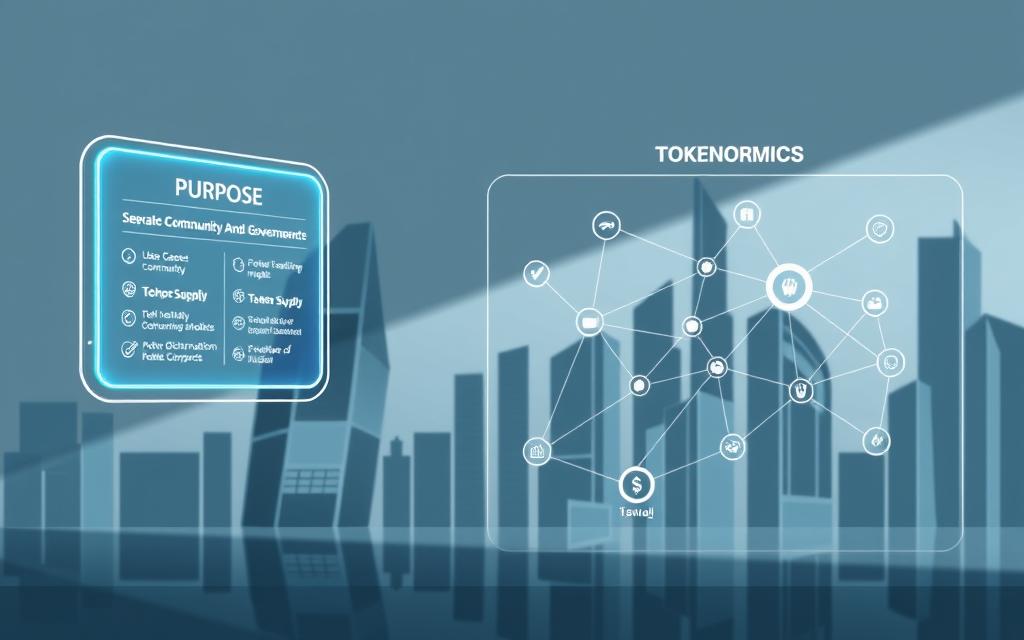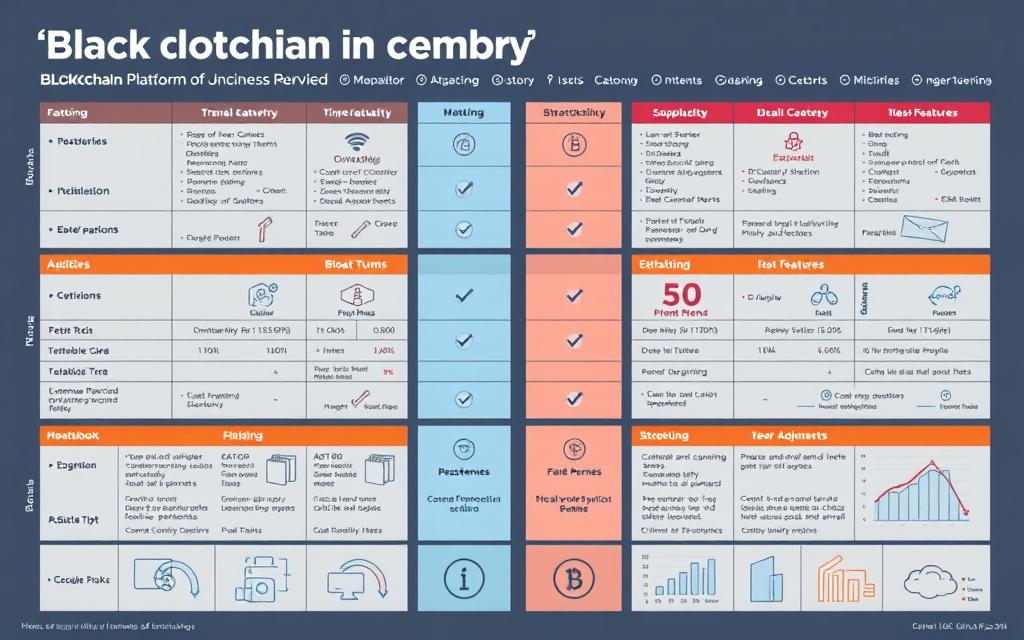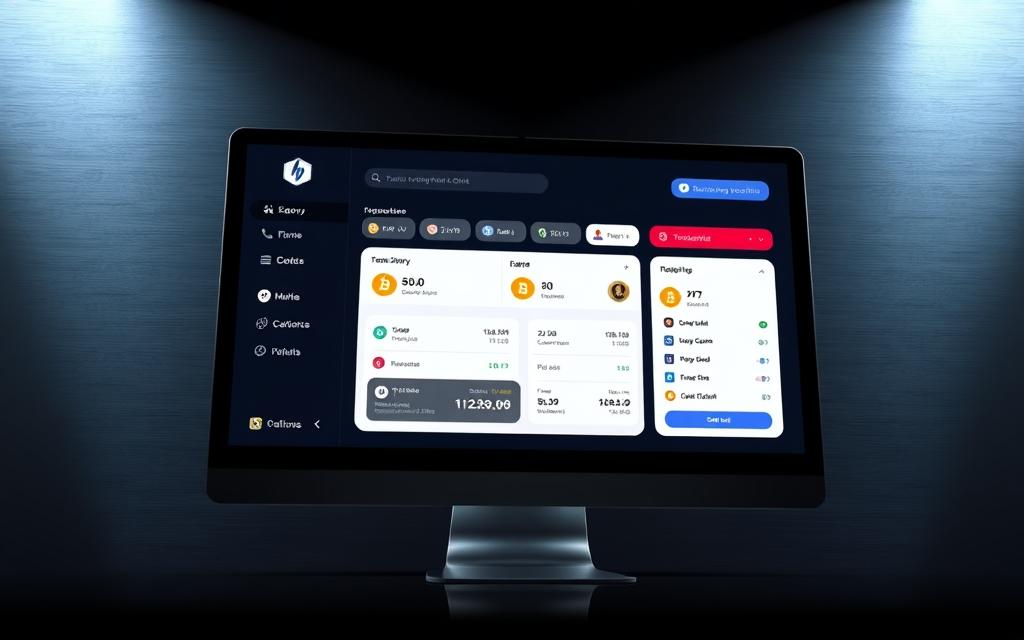Table of Contents
The digital currency market continues to expand, with over 22,000 cryptocurrencies in circulation. Developing a new blockchain asset requires careful planning, technical expertise, and market awareness.
A structured 9-step framework guides creators through key phases. This includes defining purpose, selecting consensus mechanisms, and designing tokenomics. Platforms like Ethereum offer alternatives to building independent networks.
Successful projects address legal requirements and technical architecture early. Models like Bitcoin demonstrate the importance of sustainable economic design. Energy-efficient solutions gain traction amid environmental concerns.
For deeper insights, explore cryptocurrency development strategies from industry experts. The journey begins with clear vision and audience identification.
Understanding Cryptocurrency Fundamentals
Digital assets powered by blockchain offer secure, transparent transactions. These systems eliminate intermediaries, relying on cryptographic security and decentralized networks. Before diving into development, grasp these core concepts.
What Is a Cryptocurrency?
A cryptocurrency is digital money secured by cryptography. Unlike traditional currencies, it operates on a peer-to-peer network. Bitcoin pioneered this model, proving the viability of decentralized finance.
Key Components of Blockchain Technology
Blockchain structures data into immutable, timestamped blocks. Each block links to the previous one, creating a tamper-proof ledger. This design ensures transactions remain transparent and irreversible.
Two primary models exist:
- UTXO (Bitcoin): Tracks unspent outputs like physical cash.
- Account-based (Ethereum): Balances update like bank accounts.
Major Types of Cryptocurrencies
Projects serve distinct purposes:
- Bitcoin: Store-of-value using proof-of-work.
- Ethereum: Supports smart contracts and tokens.
- Ripple: Optimizes cross-border payments.
Cardano stands out with peer-reviewed blockchain architecture. Litecoin offers faster confirmations than Bitcoin. Choose a model aligning with your project’s goals.
Defining Your Cryptocurrency’s Purpose
A well-defined mission separates impactful cryptocurrencies from short-lived trends. Every blockchain project thrives when solving real-world problems or filling gaps in the market. Start by asking: What unique value does this digital asset offer?

Identifying Target Audience and Use Cases
Pinpointing your core users ensures relevance. For example, Ethereum’s smart contracts cater to developers, while Bitcoin targets investors. Analyze use cases—whether DeFi, NFTs, or payments—to align with demand.
Future-proof your design by addressing emerging challenges:
- Adopt Proof-of-Stake to reduce energy consumption.
- Integrate zero-knowledge proofs for privacy-focused transactions.
- Build merchant APIs to bridge crypto and traditional commerce.
Developing Your Tokenomics Model
Tokenomics dictates long-term viability. Balance circulating supply with reserves to avoid inflation.
“Hybrid stablecoin models can mitigate volatility while maintaining decentralization,”
notes a leading economist.
Key considerations:
- Allocate team tokens with vesting schedules to build trust.
- Embed governance features for community-led DAO decisions.
- Study regulatory frameworks to preempt compliance risks.
Choosing the Right Consensus Mechanism
The backbone of any blockchain network lies in its consensus mechanism, determining how transactions are validated. This protocol ensures all nodes agree on the ledger’s state without central oversight. Energy use, speed, and decentralization hinge on this critical choice.
Proof of Work vs. Proof of Stake
Bitcoin’s proof-of-work (PoW) relies on miners solving complex puzzles, consuming vast energy—equivalent to Norway’s annual usage. Ethereum’s shift to proof-of-stake (PoS) cut energy use by 99.95%, prioritizing validator stakes over computational power.
Key trade-offs:
- Security: PoW resists 51% attacks but incentivizes mining centralization.
- PoS reduces energy costs but requires robust slashing conditions to penalize malicious validators.
Hybrid Consensus Models
Projects like Decred blend PoW and PoS, balancing decentralization with efficiency. Delegated PoS (DPoS), used by EOS, lets token holders vote for validators, though governance disputes can arise.
Enterprise chains like Hedera Hashgraph employ asynchronous Byzantine fault tolerance (aBFT), ensuring fast finality for high-value transactions.
Security and Efficiency Considerations
Finality times vary: Bitcoin averages 10 minutes per block, while Solana’s PoH achieves sub-second confirmations. Algorand’s pure PoS eliminates validator selection bias, whereas Tezos’ liquid PoS allows delegation flexibility.
“Hybrid models future-proof networks against evolving threats while optimizing resource use,”
advises a blockchain architect. Always audit economic incentives to prevent collusion or stagnation.
Selecting a Blockchain Platform
Choosing the right foundation determines a project’s scalability and functionality. Platforms vary in speed, cost, and decentralization levels. Align your choice with technical needs and long-term goals.

Building on Existing Blockchains
Ethereum dominates smart contract development with ERC-20 standards. Binance Smart Chain (BSC) offers cross-chain compatibility and lower fees. For speed, Solana processes 65,000 TPS, while Polygon reduces Ethereum’s gas costs by 90%.
Creating a New Blockchain
Custom chains suit niche requirements. Cosmos SDK enables interoperable networks, and Hyperledger Fabric serves enterprises. Avalanche subnets and Polkadot parachains balance customization with shared security.
“Developers should weigh trade-offs: Ethereum’s ecosystem vs. newer chains’ efficiency,”
Comparing Major Platforms
| Platform | Token Standard | TPS | Use Case |
|---|---|---|---|
| Ethereum | ERC-20 | 15–30 | Smart contracts |
| BSC | BEP-20 | 300+ | DeFi, low-cost apps |
| Polkadot | DOT | 1,000+ | Interoperability |
NEAR Protocol’s sharding enhances scalability, while Stellar specializes in payments. Evaluate consensus models, community support, and upgrade flexibility before committing.
How to Make Your Own Crypto Coin: Technical Development
Technical execution separates successful blockchain projects from conceptual ideas. This phase transforms designs into functional systems through precise code and infrastructure. Focus on three pillars: network setup, architecture, and smart contract deployment.

Node Configuration and Network Setup
Nodes validate transactions and maintain the chain. Full nodes store the entire ledger, while light nodes sync selectively. Choose clients like Geth (Ethereum) or Parity for compatibility.
| Node Type | Storage | Use Case |
|---|---|---|
| Full | Entire blockchain | Validators, miners |
| Light | Block headers only | Mobile wallets |
Security protocols vary:
- Cold wallets: Offline storage for long-term holdings.
- Hot wallets: Internet-connected for frequent transactions.
Designing the Internal Architecture
Optimize performance with libp2p for peer-to-peer communication. Use Merkle Patricia Tries for efficient state storage. Balance decentralization with throughput—Solana’s architecture achieves 65,000 TPS via parallel processing.
“Modular designs allow upgrades without hard forks,”
Smart Contract Implementation
Programming language choice affects flexibility. Solidity dominates Ethereum, while Rust suits Solana’s high-speed needs. Key steps:
- Leverage OpenZeppelin’s audited templates for ERC-20 tokens.
- Integrate Chainlink oracles for external data feeds.
- Test on Ropsten or Mumbai before mainnet launch.
Gas optimization reduces transaction costs. Multi-signature wallets (e.g., Gnosis Safe) add governance layers. Always audit smart contracts for vulnerabilities.
Implementing Essential Features
Building a functional cryptocurrency requires integrating core components that serve users effectively. From wallet connectivity to interface design, each element impacts adoption and usability. Prioritize security and scalability to ensure long-term success.

Wallet and Transaction APIs
Seamless wallet integration starts with MetaMask or WalletConnect APIs. These tools enable instant access to decentralized applications (dApps). For hardware support, embed Ledger or Trezor libraries.
Key API features include:
- Address generation using BIP-39 standards.
- Real-time balance checks via RPC endpoints.
- Gas fee estimation for transactions.
“OAuth 2.0 adds identity verification without compromising decentralization.”
User Interface Development
React and Vue.js lead frontend frameworks for dApps. Compare their strengths:
| Framework | Speed | Web3 Compatibility |
|---|---|---|
| React | Fast | Extensive (Web3.js, Ethers) |
| Vue.js | Faster | Growing (Vue-Web3) |
Design responsive dashboards with transaction explorers. Uniswap’s swap interface offers a proven template for DeFi projects.
Security Protocols
Protect users with SSL/TLS encryption for data transmission. Implement two-factor authentication (2FA) via Google Authenticator or Auth0. Rate-limiting APIs prevent DDoS attacks.
Critical audits include:
- Smart contract checks with MythX.
- Penetration testing using Slither.
- Hardware wallet confirmation prompts.
Zero-trust architectures minimize breach risks. Regular updates patch vulnerabilities in transaction workflows.
Testing Your Cryptocurrency
Rigorous testing ensures a stable and secure blockchain network before launch. Comprehensive checks validate code integrity, transaction reliability, and resistance to attacks. This phase prevents costly errors and builds user trust.
Functional Testing Methods
Unit tests verify individual components using frameworks like Truffle and Mocha. These tools simulate smart contract interactions in controlled environments. Ganache provides a local blockchain for rapid iteration.
Key testing approaches:
- Reentrancy attack simulations to expose recursive call vulnerabilities
- Edge case validation for maximum token supply and transfer limits
- Cross-chain interoperability checks for multi-network compatibility
Performance and Security Testing
LoadImpact assesses network capacity under heavy transaction volumes. Security audits use specialized tools:
| Tool | Function | Detection Capability |
|---|---|---|
| Mythril | Static analysis | Over 100 vulnerability patterns |
| Oyente | Symbolic execution | Reentrancy, timestamp dependence |
| OWASP ZAP | Frontend scanning | XSS, SQL injection risks |
“Comprehensive testing reduces mainnet failures by 83% compared to unaudited projects.”
Testnet Deployment
Public testnets like Rinkeby simulate real-world conditions. Developers use faucets to acquire test tokens for experimentation. Monitor these key metrics:
- Block propagation times across global nodes
- Gas fee fluctuations under network congestion
- Validator participation rates in PoS systems
Final audits from firms like CertiK provide professional security validation. For detailed blockchain development guidance, explore these advanced testing methodologies.
Ensuring Legal Compliance
Navigating the legal landscape is critical for any blockchain project’s longevity. Regulatory frameworks evolve rapidly across jurisdictions, requiring proactive adaptation. Non-compliance risks include asset freezes, penalties, or operational shutdowns.
Global Regulatory Frameworks
The FATF Travel Rule mandates sharing sender/receiver data for transactions exceeding $3,000. In the U.S., the SEC applies the Howey Test to determine if a token qualifies as a security. Projects must analyze:
- EU’s MiCA regulations for comprehensive cryptoasset oversight
- Singapore’s Payment Services Act licensing tiers
- Japan’s FSA registration for exchange operators
“Geofencing tools should automatically restrict access from OFAC-sanctioned regions.”
Anti-Money Laundering Protocols
Robust AML systems integrate real-time monitoring and identity verification. Compare leading solutions:
| Service | Feature | Coverage |
|---|---|---|
| Chainalysis | Transaction graphing | 150+ cryptocurrencies |
| Jumio | Biometric KYC | 200+ countries |
| Elliptic | Dark web tracing | 98% accuracy |
FinCEN requires MSB registration for users handling over $1,000 daily. GDPR-compliant privacy policies must specify data retention periods.
Taxation and Reporting
The IRS treats cryptocurrencies as property under Notice 2014-21. Key obligations:
- Form 8949 for capital gains exceeding $400
- FBAR filings for foreign-held digital assets over $10,000
- 1099-B reporting for exchange payouts
Projects should partner with tax software like CoinTracker or TokenTax. Proper documentation prevents 85% of audit disputes according to IRS data.
Creating Your Initial Coin Offering (ICO)
Initial Coin Offerings remain a powerful fundraising tool for blockchain startups. Modern projects combine regulatory compliance with innovative token economics to attract serious investors. Successful launches balance technical execution with transparent communication to build community trust.
Token Distribution Strategies
Strategic allocation prevents market dilution while rewarding early supporters. Ethereum’s 2014 ICO set industry standards with its phased distribution model.
| Model | Vesting Period | Case Study |
|---|---|---|
| Linear Release | 24-36 months | Filecoin (2017) |
| Tiered Pricing | Presale discounts | Tezos (2017) |
| Liquidity Lock | 6-12 months | Uniswap (2020) |
OpenZeppelin’s vesting contracts help automate scheduled releases. Reserve 15-20% for development teams with cliff periods to align long-term incentives.
Smart Contract for Crowdsale
ERC-20 remains the gold standard for token creation. Key smart contract features include:
- Whitelisting functions for KYC-compliant participants
- Hard caps to prevent oversubscription risks
- Refund mechanisms for unmet funding goals
“Audited crowdsale contracts reduce exploit risks by 92% compared to unaudited code.”
Integrate Chainlink price feeds for stablecoin pegs. Multi-signature wallets add governance layers for fund management.
White Paper Development
A compelling whitepaper details token utility and technical architecture. Essential components include:
- Problem-solution fit analysis with market sizing
- Consensus mechanism and node requirements
- Roadmap with quarterly milestones
Polkadot’s whitepaper demonstrates effective technical appendices. Disclose advisor credentials and audit reports from firms like Hacken to build credibility with investors.
“Projects with mathematically modeled tokenomics raise 3x more capital than those without.”
SAFT agreements provide legal protection for US-based participants. Bounty programs should use separate smart contract allocations to track community contributions.
Marketing and Community Building
Successful blockchain projects thrive when they establish strong connections with their audience. Effective strategies blend branding, engagement, and strategic partnerships to create lasting impact in the competitive market.
Branding and Positioning
Distinctive identity separates top-tier projects from imitators. Develop a visual language with memorable logos and consistent color schemes. Case studies show projects with professional branding attract 47% more investors.
Key elements include:
- Mission-driven narratives that resonate with target demographics
- Transparent team profiles with verifiable credentials
- Regular content updates across multiple platforms
“Authentic storytelling builds 3x more trust than technical specs alone.”
Community Engagement Strategies
Active participation drives network effects. Telegram groups with 10,000+ members show 72% higher token retention rates. Effective tactics include:
| Method | Frequency | Impact |
|---|---|---|
| AMA Sessions | Bi-weekly | 35% engagement boost |
| Bug Bounties | Quarterly | Security improvements |
| Governance Votes | Monthly | Decentralization metrics |
Educational initiatives like developer workshops foster long-term community growth. Reward systems should balance immediate incentives with sustainable participation.
Exchange Listings
Liquidity access remains critical for project viability. Top-tier exchanges require:
- Legal compliance documentation
- Minimum trading volume thresholds
- Technical integration testing
CEX listings provide immediate visibility, while DEX integration supports decentralization principles. Market makers ensure 24/7 order book depth, with professional services costing 0.1-0.3% of trading volume.
“Strategic exchange partnerships can increase token velocity by 400% in launch phases.”
Monitor CoinMarketCap rankings weekly to assess positioning against competitors. Adjust marketing spend based on performance metrics across different platforms.
Conclusion
The cryptocurrency landscape rewards innovation paired with robust governance. From defining tokenomics to securing exchanges, each phase shapes a project’s trajectory.
Continuous upgrades keep blockchain networks competitive. Emerging tools like ZK-rollups boost scalability, while DAOs empower decentralized decision-making.
Engage developer forums for feedback and monitor security threats proactively. Strategic partnerships amplify success. Start building—the future of finance evolves daily.
FAQ
What are the essential steps to launch a cryptocurrency?
The process involves defining purpose, selecting a consensus mechanism, choosing a blockchain platform, technical development, testing, legal compliance, and marketing. Each phase requires careful planning to ensure success.
What’s the difference between a coin and a token?
A coin operates on its own blockchain (like Bitcoin), while a token is built on an existing blockchain (like Ethereum’s ERC-20). Tokens leverage the security and infrastructure of their host network.
Why is a consensus mechanism important?
It validates transactions and maintains network security. Popular models include Proof of Work (PoW) and Proof of Stake (PoS), each with trade-offs in speed, energy use, and decentralization.
Can I create a cryptocurrency without coding?
Yes, platforms like Ethereum or Binance Smart Chain offer tools to deploy tokens with minimal programming. However, custom blockchains require advanced development skills.
What legal considerations apply to cryptocurrency projects?
Regulations vary by jurisdiction but often include AML/KYC compliance, securities laws, and tax reporting. Consulting legal experts is critical to avoid penalties.
How do I attract investors to my project?
A clear use case, strong whitepaper, active community engagement, and strategic exchange listings build credibility. Transparency and regular updates foster trust.
What role does smart contract security play?
Flaws in smart contracts can lead to exploits. Audits by firms like CertiK or OpenZeppelin identify vulnerabilities before deployment.
How long does it take to develop a cryptocurrency?
Simple tokens take days, while custom blockchains require months or years. Factors include complexity, team size, and testing rigor.









